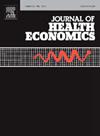健康检查项目标准化对工作年龄个体经营者和失业者的影响:来自日本地方政府对国家政策回应的见解
IF 3.6
2区 经济学
Q1 ECONOMICS
引用次数: 0
摘要
本研究分析了在引入特定健康检查和特定健康指导(SHC-SHG)之后,城市人均健康检查费用的扩大对个体经营和失业人群健康结果和行为的影响,这在很大程度上被以往的研究所忽视。为了解决这个问题,我们采用了剂量差中差(DID)估计方法,利用不同城市治疗强度的差异。世界卫生组织的估计显示,在那些需要大幅增加人均健康检查方案费用以遵守新方案的城市中,引入SHC-SHG导致被诊断患有生活方式相关疾病的人的比例下降,对多次诊断的人的影响比对单一诊断的人的影响更明显。一项亚组分析表明,自雇工人和房主在引入SHC-SHG后,健康状况有所改善,而在失业者和租房者中,这种改善并不明显。此外,我们发现在政策引入后,高扩张城市的人口发生了显著的行为变化。一个粗略的计算表明,市政对引入SHC-SHG的反应具有成本效益。本文章由计算机程序翻译,如有差异,请以英文原文为准。
Impacts of health checkup programs standardization on working-age self-employed and unemployed: Insights from Japan’s local government response to national policy
This study analyzes the effects of the expansion of municipal per capita expenses on health checkup programs, following the introduction of the Specific Health Checkups and Specific Health Guidance (SHC-SHG), on the health outcomes and behaviors of self-employed and unemployed populations, which have been largely overlooked by previous research. To address this, we applied a dosing difference-in-differences (DID) estimation method, exploiting variation in treatment intensity across municipalities. The DID estimation reveals that the SHC-SHG introduction led to a reduction in the proportion of people diagnosed with lifestyle-related diseases in the municipalities that required significant increases in per-capita health checkup program expenses to comply with the new program, with a more pronounced impact on those with multiple diagnoses compared to those with a single diagnosis. A subgroup analysis indicates that health improvements following the SHC-SHG introduction were observed among self-employed workers and homeowners, whereas such improvements were not evident among the unemployed and renters. Moreover, we identify significant behavioral changes among the population in the high-expansion municipalities following the policy introduction. A back-of-the-envelope calculation demonstrates the municipal response to the SHC-SHG introduction is cost-effective.
求助全文
通过发布文献求助,成功后即可免费获取论文全文。
去求助
来源期刊

Journal of Health Economics
医学-卫生保健
CiteScore
6.10
自引率
2.90%
发文量
96
审稿时长
49 days
期刊介绍:
This journal seeks articles related to the economics of health and medical care. Its scope will include the following topics:
Production and supply of health services;
Demand and utilization of health services;
Financing of health services;
Determinants of health, including investments in health and risky health behaviors;
Economic consequences of ill-health;
Behavioral models of demanders, suppliers and other health care agencies;
Evaluation of policy interventions that yield economic insights;
Efficiency and distributional aspects of health policy;
and such other topics as the Editors may deem appropriate.
 求助内容:
求助内容: 应助结果提醒方式:
应助结果提醒方式:


